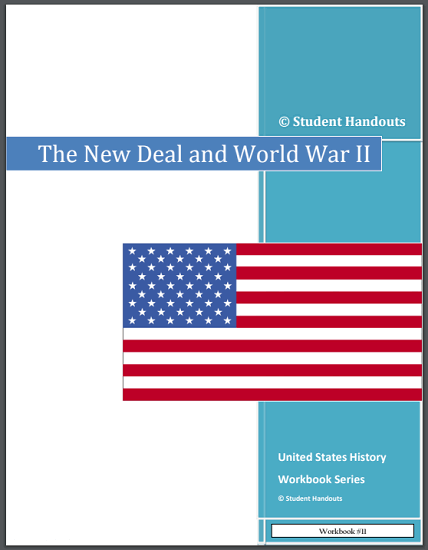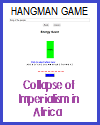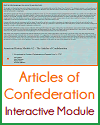| The New Deal & World War II—U.S. History Workbook |
|---|
| United States History ↣ American History Workbooks ↣ U.S. History Workbooks for High School |
|
This particular workbook covers the Second World War, New Deal, Franklin D. Roosevelt, FDIC, Civilian Conservation Corps (CCC), Public Works Administration (PWA), Federal Emergency Relief Administration (FERA), Agricultural Adjustment Act (AAA), commodity Credit Corporation, Dust Bowl, National Labor Relations Act, Father Charles Coughlin, Huey P. Long, Social Security Act of 1935, Adolf Hitler, Manchukuo, Lend-Lease program, Pearl Harbor, Rosie the Riveter, Japanese internment, Dwight D. Eisenhower, Harry Truman, Joseph Stalin, D-Day, V-E Day, Battle of Midway, Chiang Kai-shek, Manhattan Project, Nuremberg trials, Frances Perkins, John L. Lewis, Walter Reuther, and much, much more. This free PDF high school American History workbook is 27 pages in length. The answer key is below. Click here to print. |
 |
    |
|
1 Roosevelt and the New Deal 1. New Deal 2. The speed with which it accomplished what previously had taken generations 2 The First New Deal: Banking and Finance 1. State of paralysis 2. To start an upward movement in commodity prices and to afford some relief to debtors 3. Federal Deposit Insurance Corporation 3 The First New Deal: Unemployment 1. 13,000,000 (more than 25%) 2. Program that brought relief to young men between 18 and 25 years of age; enrollees worked in camps administered by the army 3. Provided employment for skilled construction workers on a wide variety of mostly medium- to large-sized projects 4. Bonneville Dam, Grand Coulee Dam, new Chicago sewer system, New York City's Triborough Bridge, U.S.S. Yorktown, U.S.S. Enterprise 5. Developed the impoverished Tennessee River valley area through a series of dams built for flood control and hydroelectric power generation 6. Operated from 1933 to 1935; distributed direct relief to hundreds of thousands of people, usually in the form of direct payments 7. Answers will vary 4 The First New Deal: Agriculture 1. By paying farmers a subsidy to compensate for voluntary cutbacks in production 2. Purchased commodities to be kept in storage, driving output down and farm prices up 3. Violent wind and dust storms combined with impoverishment of the soil 4. B - 200,000 5. Soil Conservation Service 6. Answers will vary 5 The First New Deal: Industry and Labor 1. National Recovery Administration (NRA) 2. National Labor Relations Act 6 The Second New Deal 1. Father Charles Coughlin 2. Huey P. Long 3. Works Progress Administration 4. Gave part-time employment to students, established training programs, and provided aid to unemployed youth 5. Created a system of state-administered welfare payments for the poor, unemployed, and disabled based on matching state and federal contributions 6. Public Utility Holding company Act 7. Rural Electrification Administration 7 A New Coalition 1. Unsuccessful attempt to enlarge the Supreme Court and a failed effort to "purge" increasingly recalcitrant southern conservatives from the Democratic Party 2. Radio 3. Answers will vary 8 War and Uneasy Neutrality 1. A - France 2. Manchukuo 3. C - Italy 4. A - Adolf Hitler 5. B - Permitted entry for all wartime refugees 6. U.S. gave the British Navy 50 "overage" destroyers in return for British air and naval bases in Newfoundland and the North Atlantic 7. Enabled FDR to transfer arms and equipment to any nation (notably Great Britain, later the Soviet Union and China) deemed vital to the defense of the United States 8. No territorial aggrandizement; no territorial changes without the consent of the people concerned; the restoration of self-government to those deprived of it; economic collaboration between all nations; freedom from war, from fear, and from want for all peoples; freedom of the sea; and the abandonment of the use of force as an instrument of international policy 9 Japan, Pearl Harbor, and War 1. An embargo on the export of scrap iron to Japan 2. Froze Japanese assets and initiated an embargo on oil 3. Japanese carrier-based planes executed a devastating surprise attack against the U.S. Pacific Fleet at Pearl Harbor, Hawaii 10 Mobilization for Total War 1. Rosie the Riveter 2. In February of 1942, nearly 120,000 Japanese Americans residing in California were removed from their homes and interned behind barbed wire in 10 wretched temporary camps, later to be moved to "relocation centers" outside isolated Southwestern towns 11 The War in North Africa and Europe 1. A - Africa 2. Stalingrad 3. B - false 4. U.S. General Dwight D. Eisenhower 5. June 6, 1944 6. August 25, 1944 7. May 7, 1945 12 The War in the Pacific 1. Battle of the Coral Sea 2. Battle of Midway 13 The Politics of War 1. Sought to assure the people of all the fighting nations that no separate peace negotiations would be carried on with representatives of Fascism and Nazism and there would be no compromise of the war's idealistic objectives 2. Chiang Kai-shek 3. Harry Truman 14 War, Victory, and the Bomb 1. Battle of the Philippine Sea 2. February, 1945 3. Japanese suicide planes 4. A - Emperor Hirohito 5. Manhattan Project 6. Hiroshima and Nagasaki 7. September 2, 1945 8. October 24, 1945 9. Nazis were accused of violating the laws of war and of humanity in the systematic genocide, known as the Holocaust, of European Jews and other peoples 15 The Rise of Industrial Unions 1. Offering workers various pension, profit-sharing, stock option, and health plans to ensure their loyalty 2. Prevented a union from being the exclusive representative of all workers 3. Frances Perkins 4. John L. Lewis 5. Walter Reuther 6. It became the organizational core of the national Democratic Party; gained material benefits for its members that all but erased the economic distinction between working-class and middle-class America |
| United States History ↣ American History Workbooks ↣ U.S. History Workbooks for High School |








